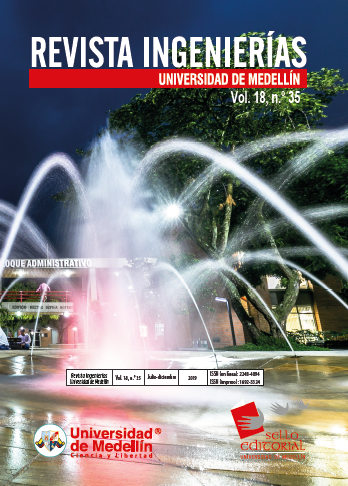Derechos de autor 2023 Revista Ingenierías Universidad de Medellín

Esta obra está bajo licencia internacional Creative Commons Reconocimiento-NoComercial-SinObrasDerivadas 4.0.
- Articles
-
Publicado: mayo 27, 2016
Resumen
El ambiente térmico en una edificación influye en la salud, el bienestar y la productividad de las personas, así como en el consumo energético. La importancia del confort térmico en las edificaciones se reconoce desde hace décadas, no obstante, este aspecto es aún incipiente en la industria de la construcción colombiana, sobre todo en proyectos de vivienda. En esta investigación se analizó el desempeño térmico de tres tipos de vivienda comunes en la ciudad de Medellín. Para ello se calculó la temperatura operativa, el voto medio estimado (PMV) y el porcentaje estimado de insatisfechos (PPD), de acuerdo con la norma ISO 7730:2005. Los resultados mostraron que la inercia térmica de dos de los tres tipos de vivienda examinados no es suficiente para ofrecer un confort térmico adecuado, a pesar del clima templado del Valle de Aburrá. Estos resultados alertan sobre la vulnerabilidad de la población urbana en Colombia ante fluctuaciones extremas de temperatura.
Referencias
[1] Thermal Environmental Conditions for Human Occupancy, ANSI/Ashrae Standard 55-2017, American Society of Heating, Refrigerating and Air-Conditioning Engineers, 2017.
[2] H. M. Vernon y C. G. Warner, “The influence of the humidity of the air on capacity for work at high temperatures,” Journal of Industrial Hygiene, vol. 32, n.° 3, pp. 431-463, 1932. DOI: https://doi.org/10.1017/S0022172400018167
[3] P. O. Fanger, “Calculations of thermal comfort: introduction of a basic comfort equation,” Ashrae Transactions, vol. 73, n.° 2, pp. 1-4, 1967.
[4] A. P. Gagge et al., “An effective t emperature scale based on a simple model of human physiological regulatory response,” Ashrae Transactions, vol. 77, pp. 247-262, 1971.
[5] L. G. Berglund y A. P. Gobelets, “Subjective human response to low-level air current and asymmetric radiation,” Ashrae Transactions, vol. 93, pp. 497-523, 1987.
[6] Ergonomía del ambiente térmico, Aenor, Asociación Española de Normalización y Certificación, Estándar UNE-EN ISO 7730, 2006.
[7] H. Frederick y J. Rohles, “Temperature and temperament. A psychologist looks at comfort,” Ashrae Journal, vol. 49, pp. 14-22, 2007.
[8] J. Anderson y M. French, “Sustainability as promoting well-being: psychological dimensions of thermal comfort,” [En línea], Disponible: https://www.irbnet.de/daten/iconda/CIB20934.pdf, 2010.
[9] K. Fabbri, Indoor thermal comfort perception. A questionnaire approach focusing on children, Switzerland: Springer International Publishing, 147 p., 2015. DOI: https://doi.org/10.1007/978-3-319-18651-1
[10] A. P. Gagge, “The linearity criterion as applied to partitional calorimetry,” American Journal of Physiology, vol. 116, n.° 3, pp. 656-668, 1936. DOI: https://doi.org/10.1152/ajplegacy.1936.116.3.656.
[11] CCCS, “Consejo Colombiano de Construcción Sostenible. La vivienda sostenible se abre espacio en el país,” Revista Portafolio, [En línea], Disponible: https://www.cccs.org.co/wp/download/la-vivienda-sostenible-abre-espacio-en-el-pais/?wpdmdl=15044, 2017
[12] Eronomics of the termal environment – Instruments for measuring physical quantities, International Organization for Standarization, , Estándar ISO 7726, 1998.
[13] F. Fernández-García, “Fundamentos físicos y métodos de evaluación del confort climático en los estudios de bioclimatología humana,” presentado en VI Reunión Nacional de Climatología,Santiago de Compostela, 2000.
[14] Ashrae, 2001 Ashrae Handbook: fundamentals, Atlanta: American Society of Heating,Refrigerating and Air-Conditioning Engineers, 544 p, 2001.
[15] S. Verbeke y A. Audenaert, “Thermal inertia in buildings: A review of impacts across climate and building use,” Renewable and Sustainable Energy Reviews, vol. 82, n.° 3, pp. 2300-2318, 2018. DOI: https://doi.org/10.1016/j.rser.2017.08.083
[16] K. Ulgen, “Experimental and theoretical investigation of effects of wall´s thermophysical properties on time lag and decrement factor,” Energy and Buildings, vol. 32, n.° 3, pp. 273-278, 2002. DOI: https://doi.org/10.1016/S0378-7788(01)00087-1
[17] P. Tuohy et al., “Thermal mass, insulation and ventilation in sustainable housing - an investigation across climate and occupancy,” presentado en IX International IBPSA Conference, Montreal, 2005.
[18] S. Ferrari, “Building envelope and heat capacity: re-discovering the thermal mass for winter energy saving,” presentado en 2nd Palenc Conference and 28th AIVC Conference on Building Low Energy Cooling and Advanced Ventilation Technologies in the 21st Century, Creta, 2007.
[19] L. Zhu et al., “Detailed energy saving performance analyses on thermal mass walls demonstrated in a zero energy house,” Energy and Buildings, vol. 41, n.° 3, pp. 303-310, 2009. DOI: https://doi.org/10.1016/j.enbuild.2008.10.003
[20] M. Scott, “Beating the Heat,” Nasa Earth Observatory, [En línea], Disponible: http://earthobservatory.nasa.gov/Features/GreenRoof/, 2006.
[21] D. Campbell-Lendrum y C. Corvalán, “Climate change and developing-country cities: implications for environmental health and equity,” Journal of Urban Health, vol. 84, n.° 1, pp. 109-115, 2007. DOI: https://doi.org/10.1007/s11524-007-9170-x


















